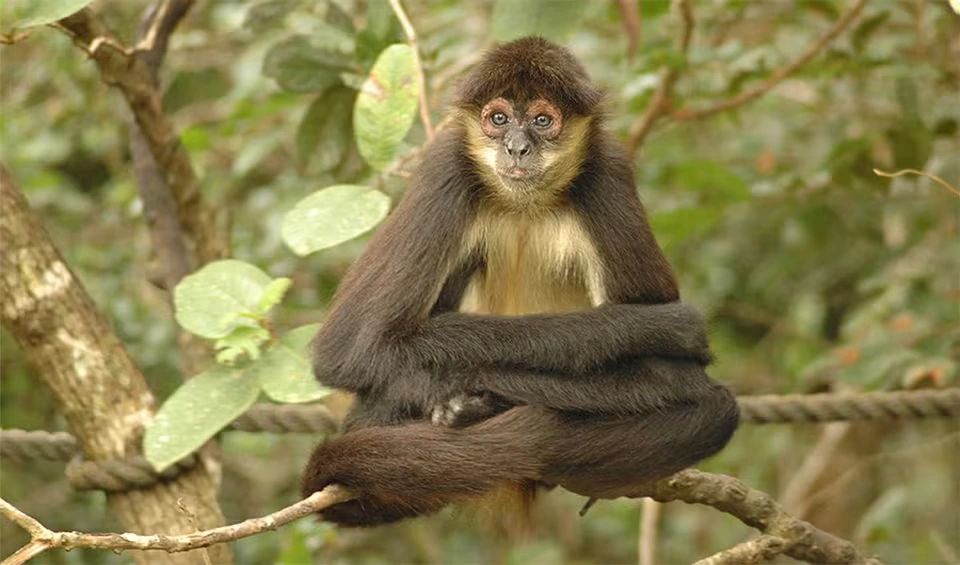‘It’s about as likely that an ape will prove to have a language ability as there is an island somewhere with a species of flightless birds waiting for humans to teach them to fly.’
— Noam Chomsky
Chomsky’s dismissal of animal language may have been valid in his time, but breakthroughs in both science and technology are changing the way we understand animal communication.
Geoffroy’s spider monkeys, one of the most intelligent non-human primates, are super hard to track. They spend their time high up in the rainforest canopy, out of sight. Biologist Jenna Lawson did something unthinkably smart. She placed 350 audio monitors in trees across Costa Rica’s Osa Peninsula to listen for these primates.
The monitors collected tons and tons of sound data for a week. The data was so heavy, it would’ve taken years to filter through. Lawson didn’t have time for that. Instead, she fed the recordings into AI systems trained to recognize monkey calls.

AI didn’t just help monitor the monkeys. It revealed critical signs about the health of the entire forest ecosystem. The fewer monkey calls and the irregular movement patterns highlighted alarming disruptions, likely caused by human activities. This research—among one of the largest of its kind—revealed how deeply interconnected animal behavior is with environmental stability.
This breakthrough raises an even more intriguing question: If AI can help us decode the calls of monkeys to protect forests, is it possible that the same technology could help us break through the ancient barrier that separates humans from the rest of the animal kingdom? Could we be on the cusp of understanding the unspoken languages of the wild?
“We patronize them for their incompleteness, for their tragic fate of having taken form so far below ourselves. And therein we err, and greatly err. For the animals shall not be measured by man. In a world older and more complete than ours, they move finished and complete, gifted with extensions of the senses we have lost or never attained, living by voices we shall never hear.”
— Henry Beston
The impossible language barrier
Animals express themselves constantly. Whether it's the click of a dolphin's whistle, the growl of a wolf, or the moo of a cow—each sound carries meaning. Yet, these are expressions we still struggle to fully interpret or understand, as if we're missing the key to a secret language.
From an evolutionary perspective, human language developed primarily for social bonding. According to Robin Dunbar’s theory, language evolved as a tool for gossip and complex social interaction, which, in today’s world of Twitters and Reddits, often revolves around (let’s face it) insults and viral debates. Animals, by contrast, developed their calls and signals to convey more basic messages—likely rooted in survival instincts. These calls were less about abstract thoughts and more about immediate needs.
“Predator! Food! Mate!”
Animals are not “unintelligent.” Take crows, for example—they can recognize human faces and hold grudges, a skill that’s both impressive and, admittedly, a little terrifying. But even the smartest animals seem to lack the inclination to evolve language systems capable of expressing abstract human concepts—things like free will, Universal Basic Income, or existential dread.
Until Alex came along.
Alex, the Existentialist parrot
There’s no shortage of researchers who’ve tried to teach animals human language. In the 1970s, Koko the gorilla made headlines by learning over 1,000 signs in American Sign Language (ASL), though skeptics argue many of her “conversations” were more about handler interpretation than actual communication. Then there’s Alex, the African Grey parrot, who mastered around 150 words and used them in surprisingly context-appropriate ways. He even asked an existential question: “What color?” after looking into a mirror—a move that, until then, no ape had ever made.
But not everyone was convinced. Clive Wynne, an animal psychologist at Arizona State University, had serious doubts about the Alex experiment. He questioned why Alex was the only parrot to achieve such feats, suggesting that true scientific validity requires replication—and that one "miracle case" doesn’t make a reliable theory.
As Noam Chomsky, father of modern linguistics, might argue, animals lack the “language acquisition device”—the cognitive hardware that makes humans uniquely chatty.
Could technology help animals speak our language?
If animals can't naturally develop human-like language, could technology step in and help? The good news is that scientists are already making significant progress in decoding non-human communication.
Cracking the code of Whale songs
One of the most exciting projects in this area is Project CETI (Cetacean Translation Initiative), which is using machine learning to decode the complex songs of sperm whales. By outfitting free-swimming whales with bio-logging tags, scientists can track their clicks, movements, and vocalizations. Early findings suggest that whales might even have their own form of grammar—a discovery that challenges everything we thought we knew about animal communication.
If humans and animals could truly communicate, the world could become Disneyland.
Translating thousands of animal species’ “communicative sounds” is no small task—imagine a universal translator that works for everyone from whales to ants. But this isn’t as far-fetched as it seems. Training AI models on large datasets of animal sounds could help systems learn to distinguish between different types of vocalizations, much like a human interpreter differentiates between languages.
A Starfleet universal translator in 2151, from Star Trek

The Earth Species Project: AI Meets Wildlife
One organization leading the charge is the Earth Species Project (ESP), a non-profit with a bold mission: to use artificial intelligence to decode the communication of non-human species. By analyzing patterns in animal vocalizations, body movements, and even behaviors, ESP is pioneering a future where AI helps us better understand the sophistication and intelligence in the animal kingdom.
The goal is not to build a “translator that will allow us to speak to other species,” Director of Impact Jane Lawton spoke to APNews.

“We believe that by reminding people of the beauty, the sophistication, the intelligence that is resident in other species and in nature as a whole, we can start to, kind of, almost repair that relationship.”
— Jane Lawton
At McGill University, AI technology is being used to listen to finches' calls during simulated conversations, and respond with its own vocalizations. These recordings are then used to train language models that can interpret animal sounds by a research group in Berkeley, California.
This fall, ESP also unveiled NatureLM-audio, the first large audio-language model designed specifically for animals. Not only does it identify species, but it can discern traits like sex and life stage. In tests on zebra finches—a species it hadn't been trained on—NatureLM accurately counted the birds with surprising precision, far beyond chance. This could soon scale to work across a wide range of species, marking a monumental leap in our ability to understand animal communication.
Closer to home, apps like MeowTalk and Sylvester.ai are attempting to decode our cats' moods, translating their meows and facial expressions into emotional insights. Cats are notoriously difficult to read, and while MeowTalk can’t offer perfect translations (since, after all, cats don’t exactly speak a “language” in the human sense), it provides a glimpse into how AI could help us understand our pets' emotional states.
"We will probably never be able to convert a cat's miaow into human words," Anita Kelsey, cat behaviorist and author of 'Let's Talk About Cats', told BBC. "All we can do is have fun thinking about what they might be saying from our own human perspective.”
A future of healing
The applications of AI-driven animal communication go far beyond mere curiosity. In countries like India, where stray dog attacks are common—averaging over 10,000 cases daily between 2019 and 2022—AI could provide a critical bridge in preventing conflicts. By helping us understand animal behavior more clearly, this technology could make streets safer for both humans and animals, fostering a more peaceful coexistence.
For service and working animals, AI could revolutionize training methods, making search-and-rescue operations more efficient and effective. The ability to better interpret an animal’s needs or intentions could directly impact life-saving missions, improving response times and success rates.
In the realm of veterinary medicine, AI’s potential is also immense. By understanding an animal’s symptoms in real-time, AI could assist veterinarians in diagnosing conditions faster and more accurately, leading to quicker treatments and better outcomes.
For farmers, AI-driven communication tools could transform the way they monitor and care for livestock, offering insights into animal health, stress levels, and well-being—critical for both productivity and animal welfare.
And yet, perhaps the most profound impact of AI in animal communication is not just in solving practical problems, but in promoting empathy and mutual respect. The more we understand animals’ needs and experiences, the more we may come to recognize that their world isn’t so different from our own. In understanding their lives, we might just find insights that transform our own.


.webp&w=2048&q=75)
